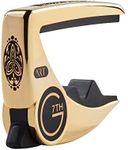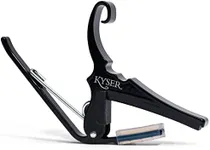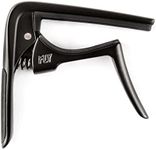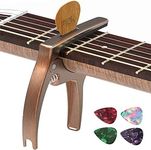We Use CookiesWe use cookies to enhance the security, performance,
functionality and for analytical and promotional activities. By continuing to browse this site you
are agreeing to our privacy policy
Best Guitar Capos
From leading brands and best sellers available on the web.#2
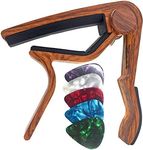
WINGO
WINGO Guitar Capo for 6-String Acoustic Electric Guitars and Bass -Rosewood Color Free 5 Picks
View Product
#3

Planet Waves
D'Addario Tri-Action Capo - Silver (PW-CP-09S)
View Product
#4
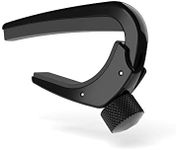
Planet Waves
Planet Waves NS Capo, Black
View Product
#5

Planet Waves
35%OFF
D'Addario Pro Plus Capo, Black (PW-CP-19)
View Product
#6

Planet Waves
23%OFF
D’Addario Guitar Capo – NS Tri Action - For 6-String Electric and Acoustic Guitars – Micrometer Tension Adjustment for Buzz-Free, In-Tune Performance - Single Hand Use – Integrated Pick Holder - Black
View Product
#7
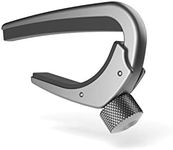
Planet Waves
9%OFF
D'Addario Ns Capo Pro - Silver (PW-CP-02S)
View Product
#8

D'Addario Accessories
19%OFF
D'Addario Ns Classical Capo Pro - Black (PW-CP-04)
View Product
#9

D'Addario Accessories
D'Addario Classical Capo, Lite (PW-CP-16)
View Product
#10
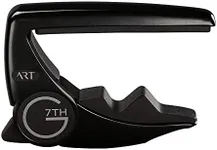
G7th
G7th Performance 3 Capo with ART, black (C81020)
View Product
Buying Guide for the Best Guitar Capos
Choosing the right guitar capo can make a big difference in your playing experience. A capo is a small device that clamps onto the neck of your guitar, allowing you to change the pitch of the strings without having to retune or learn new chord shapes. The right capo should be easy to use, fit your guitar well, and not interfere with your playing. When picking a capo, it's important to consider how it attaches, how much pressure it applies, and whether it's comfortable for your style and instrument.Type of CapoThe type of capo refers to the mechanism it uses to clamp onto the guitar neck. Common types include spring-loaded (trigger), screw, toggle, and partial capos. Spring-loaded capos are quick and easy to use, making them great for live performances or frequent changes. Screw capos allow for more precise pressure adjustment, which can be better for delicate or vintage guitars. Toggle capos are lightweight and simple but may not fit all neck shapes perfectly. Partial capos only cover some strings, allowing for creative tunings. To pick the right type, think about how often you’ll need to move the capo, how much control you want over pressure, and whether you want to experiment with alternate tunings.
MaterialCapos are made from materials like plastic, aluminum, or steel. The material affects the capo’s weight, durability, and sometimes the tone. Plastic capos are lightweight and affordable but may wear out faster. Aluminum capos are a popular balance of lightness and strength, while steel capos are very durable but can be heavier. If you play often or travel with your guitar, a sturdy material like aluminum or steel is a good choice. If you want something light and easy to carry, plastic might be enough for casual use.
PaddingPadding is the soft material on the part of the capo that touches your guitar strings and neck. Good padding protects your guitar from scratches and helps distribute pressure evenly across the strings. Thicker, softer padding is gentler on your guitar but may wear out faster, while firmer padding lasts longer but can be less forgiving. If you have a delicate or expensive guitar, look for a capo with high-quality, soft padding. For everyday use, standard padding is usually sufficient.
Pressure AdjustmentPressure adjustment refers to how much force the capo applies to the strings. Too much pressure can make your guitar go out of tune or cause buzzing, while too little pressure can result in muted or buzzing strings. Some capos have adjustable screws or dials to fine-tune the pressure, while others have a fixed amount. If you play different guitars with varying neck shapes or string gauges, an adjustable capo gives you more flexibility. For a single guitar with standard strings, a fixed-pressure capo is usually fine.
Compatibility with Guitar NeckNot all capos fit every guitar neck shape or size. Some are designed for flat fretboards, while others are made for curved (radiused) fretboards. Using the wrong shape can cause uneven pressure and buzzing. Check whether your guitar has a flat or curved fretboard and choose a capo that matches. If you play both acoustic and electric guitars, look for a capo that’s designed to work with both types.
Ease of UseEase of use is about how quickly and comfortably you can put the capo on and take it off. Some capos are designed for one-handed operation, which is helpful if you need to change positions during a song. Others may require two hands or more time to adjust. If you perform live or switch keys often, a quick-release or trigger-style capo is ideal. If you mostly play at home and don’t move the capo much, ease of use may be less important.

